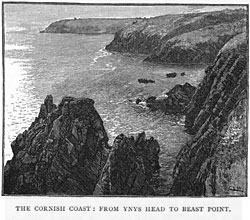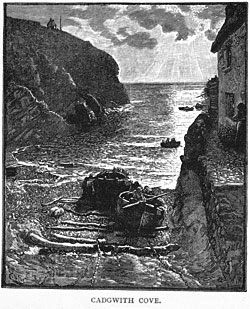|
Notes l Bibliography l Download Issue 10 
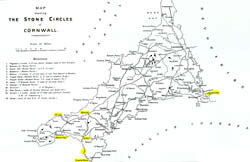 |
|
A 1906 map of the Cornish Peninsula showing the remains of ancient stone circles, as well as major towns and landmarks. All locations mentioned in "The Devil's Foot" are marked in yellow. From The Victoria History of the County of Cornwall, vol. I, Ed. William Page (London: St. Catherine's Press, 1906) |
It was, then, with considerable surprise that I received a telegram from Holmes last Tuesday.... (1)
Holmes has retired to his cottage on the Sussex Downs, and Watson, presumably, is still in London.
...aggravated, perhaps, by occasional indiscretions of his own. (1)
Holmes has been known to use cocaine and smoke too much strong tobacco, two habits that Watson deplores.
...Dr. Moore Agar, of Harley Street, whose dramatic introduction to Holmes I may some day recount.... (1)
Harley Street, in the London borough of Westminster (near Parliament and other government offices), is known for its profusion of hospitals, doctors' offices, and clinics of all kinds. The words "Harley Street" have become a metonym for the medical profession.
The story of Holmes's "dramatic introduction" to Dr. Moore Agar unfortunately remains untold.
...a small cottage near Poldhu Bay, at the farther extremity of the Cornish peninsula. (3)
The rugged, storied land of Cornwall juts out from the southwest corner of England. Stone ruins left by early Celtic inhabitants, and later Roman occupiers, are still visible today. Cornwall is associated with many legends, and is sometimes linked with magic and witchcraft. King Arthur and the Knights of the Round Table are supposed to have inhabited the northeastern part of Cornwall.
The "farther extremity of the Cornish peninsula" is Lizard Point, the southernmost tip of England (the westernmost point of Cornwall is Land's End). Just northwest of Lizard Point lies Poldhu Cove (not Bay), marked with a yellow dot on the map, where Guglielmo Marconi conducted his radio transmission experiments in 1901.
...we looked down upon the whole sinister semicircle of Mounts Bay, that old death trap of sailing vessels, with its fringe of black cliffs and surge-swept reefs on which innumerable seamen have met their end. (3)
Mounts Bay is the semicircular bay between Land's End at the west and Lizard Point. The town of Penzance, home of Gilbert and Sullivan's fictional pirates, lies at its center. As Watson says, it is notorious for shipwrecks.
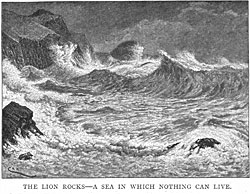 |
|
|
| Cornwall is famed for its rough, tempestuous seas. Here are two views of rugged coves on the west coast of Lizard Point, near Holmes and Watson's lodging at Poldhu Cove. The Lion Rocks are found at Kynance Cove, just south of Poldhu Cove. From Dinah Craik, An Unsentimental Journey through Cornwall. |
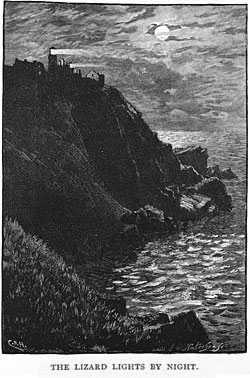 |
|
The lighthouse at Lizard Point by night. From Dinah Craik, An Unsentimental Journey through Cornwall (London: Macmillan, 1884) |
...there were traces of some vanished race which had passed utterly away, and left as its sole record strange monuments of stone, irregular mounds which contained the burned ashes of the dead, and curious earthworks which hinted at prehistoric strife. (3)
Watson is conflating different remains from over five thousand years of human habitation. Neolithic burial chambers still exist in Cornwall, but standing stones and burial mounds date from the Bronze Age. Iron Age sites seem to include fortifications, which have been thought to suggest conflicts during that era. The Romans left traces of their passing as well (see map, above).
The ancient Cornish language had also arrested his attention, and he had, I remember, conceived the idea that it was akin to the Chaldean, and had been largely derived from the Phoenician traders in tin. (3)
Holmes is making some wild leaps here. While a tin trade was apparently carried on in ancient times, the involvement of Phoenician traders is purely conjectural. The Cornish language, revived during the 19th century and still spoken today, is related to other Celtic languages such as Welsh. Chaldean is another name for Aramaic, an ancient Middle-Eastern language with no apparent connection to Cornish.
...a consignment of books upon philology.... (3)
"Philology" is the study of the history of languages—their origins, relations, and evolution over time.
...the hamlet of Tredannick Wollas.... (4)
There is no such village in Cornwall.
...Mr. Mortimer Tregennis, an independent gentleman.... (4)
Mr. Tregennis is independent because he has an income, probably either from capital that he has invested, or from a family trust.
 |
|
Roman remains in Cornwall. From The Victoria History of the County of Cornwall, 1906. |
...like an old hound who hears the view-halloa. (4)
The "view-halloa" was the cry raised by the foxhunter who first spotted the fox.
 |
|
|
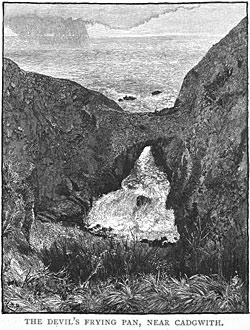 |
| Three picturesque locations on the west coast of Lizard Point: Poltesco, Cadgwith Cove, and the Devil's Frying Pan. From Dinah Craik, An Unsentimental Journey through Cornwall. |
"It's devilish, Mr. Holmes; devilish!" cried Mortimer Tregennis. "It is not of this world. Something has come into that room which has dashed the light of reason from their minds. What human contrivance could do that?" (5)
Cornwall has a mythical tradition of witchcraft, and even today "wise women" practice spells among the ancient stone circles. Conan Doyle must have been aware of that tradition when he set this story, with its suggestion of black magic, in Cornwall. See the website of the Cornish Folklore Society at http://www.cornishfolklore.com/witches.htm for a brief history and links to other witchcraft sites.
"...proposed a game of whist...." (5)
Whist is a trick-taking card game—a predecessor of bridge. It enjoyed enormous popularity in the 18th and 19th centuries. A rubber is a full round, usually two games out of three. See the notes to "The Empty House" for pictures of some hands of whist.
"We were a family of tin-miners at Redruth...." (5)
Redruth, an inland town in Cornwall, was an English mining center for many years (see map, above). Traditionally, tin was the primary metal mined, but copper mining took precedence during the Industrial Revolution. Most miners were terribly poor; the Tregennis family must have been mine owners, not mine workers, to have earned a comfortable living.
"They are taking them to Helston." (6)
Helston is an inland town about 11 miles due north of Lizard Point (see map, above).
...to rejoin her family at St. Ives. (7)
St. Ives is a coastal town on the north-facing side of the Cornish peninsula, about 23 miles from Lizard Point (see map, above). "Let us walk along the cliffs together and search for flint arrows." (8)
Holmes and Watson would be more likely to find larger flint tools from burial mounds than arrowheads.
"...and devote the rest of our morning to the pursuit of neolithic man." (8)
The Neolithic era, also referred to as the New Stone Age, lasted from approximately 4000 to 2000 B.C., and is characterized by the shift from hunting and gathering to agriculture and animal husbandry. The Neolithic inhabitants of Cornwall (and of Devon, to the east) lived in huts made of perishable materials, so traces of their homes are detectable only by archaeologists. Their stone tombs, formerly covered by earth, are the most tangible evidence of their existence. The Bronze Age people who followed them left the remains of stone huts, as well as standing stone circles and burial mounds.
...Dr. Leon Sterndale, the great lion-hunter and explorer. (9)
Dr. Sterndale is something of an outdated caricature, even for Conan Doyle's time. Africa was largely colonized when this story was written, and the day of the mythical explorer had passed, as had most of the romance associated with such a figure. Joseph Conrad's 1899 novel, Heart of Darkness, questioned the behavior of white colonials towards the people they had subjugated, and Conan Doyle himself wrote The Crime of the Congo (1909) to denounce the enslavement, torture, and mass slaughter of the people of the so-called "Congo Free State" (now the Democratic Republic of the Congo) by their Belgian colonizers.
...buried in the lonely wood of Beauchamp Arriance. (9)
There is no such wood in Cornwall.
"...I had got as far as Plymouth upon my way to Africa...." (9)
Plymouth is a city in southwest Devon, about 80 miles east of Poldhu Cove.
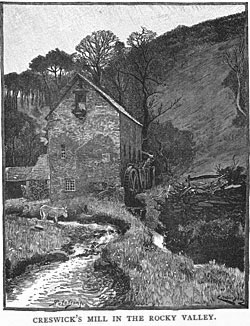 |
|
Creswick's Mill in the Rocky Valley, inland from the north coast of Cornwall. From Dinah Craik, An Unsentimental Journey through Cornwall. |
...saw a dogcart coming at a gallop down the road. (9)
An all-purpose cart that could haul passengers and their luggage, or could be converted to other uses.
One realized the red-hot energy which underlay Holmes's phlegmatic exterior.... (10)
The ancient physician Hippocrates (460-370 BC) conjectured that human behavior was influenced by bodily fluids, the four "humors": blood (associated with a sanguine, or cheerful, temperament), bile (associated with a choleric, or driven, temperament), black bile (associated with a melancholic temperament), and phlegm (associated with a phlegmatic, or calm and emotionless temperament). Today the terms are usually used metaphorically. ...like a dashing foxhound drawing a cover. (10)
In traditional foxhunts, now all but outlawed in England, the hounds flushed the fox out of its hiding place, or "covert" (pronounced "cover").
...the talc shield which covered the top of the chimney.... (11)
Talc is a soft mineral that does not burn. The talc shield acts as a smoke guard.
...which he placed in his pocket-book. (11)
Watson is referring to Holmes's wallet.
"It is not for me, my dear Watson, to stand in the way of the official police force. I leave them all the evidence which I found." (11)
As in "The Abbey Grange" and many other cases, Holmes "plays fair" with the police, giving them a fighting chance to arrive at a solution, if they can.
"It was an unjustifiable experiment even for oneself, and doubly so for a friend. I am really very sorry." (13)
Watson was forewarned about this tendency of Holmes'. His friend Stamford, who introduced Watson to Holmes, told him:
Holmes is a little too scientific for my tastes—it approaches to cold-bloodedness. I could imagine his giving his friend a little pinch of the latest vegetable alkaloid, not out of malevolence, you understand, but simply out of a spirit if inquiry in order to have an accurate idea of the effects. To do him justice, I think that he would take it himself with the same readiness. He appears to have a passion for definite and exact knowledge.
From A Study in Scarlet (1887)
"I saw no one."
"That is what you may expect to see when I follow you." (13)
Holmes's tart answer is an often-quoted Sherlockism.
"I believe that you are the devil himself!" he cried.
Holmes smiled at the compliment. (15)
Unlike Conan Doyle, Holmes does not believe in the supernatural, but he does not mind if others think his powers have a whiff of sulfur about them.
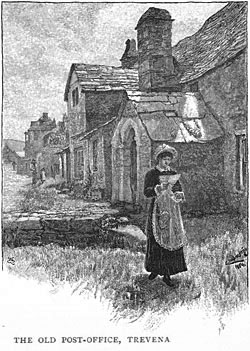 |
|
The old post office in the north-Cornwall town of Trevena, today known as Tintagel, where King Arthur is said to have lived. From Dinah Craik, An Unsentimental Journey through Cornwall. |
"...for I have a wife who has left me for years, and yet whom, by the deplorable laws of England, I could not divorce." (15)
Under the 1857 Matrimonial Causes Act, divorce was allowed in England, but men and women were not given equal access to it under the law until 1923. A man could divorce if he could prove that his wife had committed adultery; a woman had to prove adultery and either incest, cruelty, bigamy, or desertion. Sterndale apparently cannot prove that his wife engaged in "criminal conversation" with another man, and thus cannot divorce her.
...under his brindled beard. (15)
"Brindled" means streaked with different colors.
"...in a laboratory at Buda...." (15)
“Buda,” the medieval capital of Hungary, and “Pest” (or “Pesth”) were combined into Budapest in 1872.
"It has not yet found its way either into the pharmacopoeia or into the literature of toxicology." (15)
The "pharmacopoeia" is the collection of drugs classified and used by medical science. "Toxicology" is the study of poisons. "It is used as an ordeal poison by the medicine-men in certain districts of West Africa...." (15)
An "ordeal" is a general name for initiation ceremonies introducing young men into adulthood.
"...in the Ubanghi country." (15)
The "Ubanghi," or "Ubangi," River divides the Central African Republic from the Democratic Republic of the Congo. Conan Doyle is using the word as a loose reference to central Africa, formerly colonized by France and Belgium.
"I had intended to bury myself in Central Africa. My work there is but half finished."
"Go and do the other half," said Holmes. "I, at least, am not prepared to prevent you." (16)
Once again, Holmes takes the law into his own hands and dispenses justice as he sees fit. As in several other stories, Holmes is content if a malefactor leaves England for another part of the world. What "work" Sterndale intends to complete is unknown; all we know of him is that he is "a great lion-hunter and explorer" (9).
"I have never loved, Watson, but if I did, and if the woman I loved had met such an end, I might act even as our lawless lion-hunter has done. Who knows?" (16)
This pronouncement requires quite a leap of faith. Holmes "has never loved," and yet, apparently, he can sympathize with the murderous rage of someone who has. Conan Doyle seems to be speaking about his own strong feelings through Holmes. In 1897, Conan Doyle met Jean Leckie, the love of his life. Unfortunately, his wife Louise (known as “Touie”), with whom he had enjoyed a congenial, but not passionate, relationship, was ill with tuberculosis. Too honorable to leave her or to have an affair, Conan Doyle put his passion aside and cared for her. She died in 1906 without ever knowing that she had a rival. Ever the gentleman, Conan Doyle waited until a year after Touie’s death to marry Jean. One can imagine how he would feel if someone murdered the woman he had sacrificed so much to win.
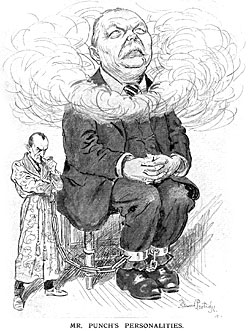 |
Cartoon by Bernard Partridge, Punch, or the London Charivari, May 12, 1926 |
In 1887, the year that the first Holmes story was published, Conan Doyle was already interested in spiritualism. As he attended more séances, he grew more credulous, and was not afraid to state his opinions. This frankness did his reputation no good; people had trouble understanding how the creator of the "reasoning machine" who was Sherlock Holmes could fail to see that spiritualism was a fraud. Punch, a satirical magazine published from 1841 to 2002, took a shot at Conan Doyle with one of its famous cartoons, and a rhyme to match.
Your own creation, that great sleuth
Who spent his life in chasing Truth—
How does he view your late defiance
(O ARTHUR!) of the laws of science?
He disapproves your strange vagaries,
Your spooks and photographs of fairies;
And holds you foot-cuffed when you're fain
To navigate the vast inane.
We sympathize with Holmes; and yet
In Punch's heart your name is set;
Of every DOYLE he's still a lover
For DICKY's sake, who did his cover.
("Dicky," or Richard Doyle, was Conan Doyle's paternal uncle, a famous cartoonist who designed the cover of Punch, with its namesake—the hook-nosed, cynical character from the traditional Punch and Judy shows.)
See Punch.co.uk for a history of the magazine.
|




